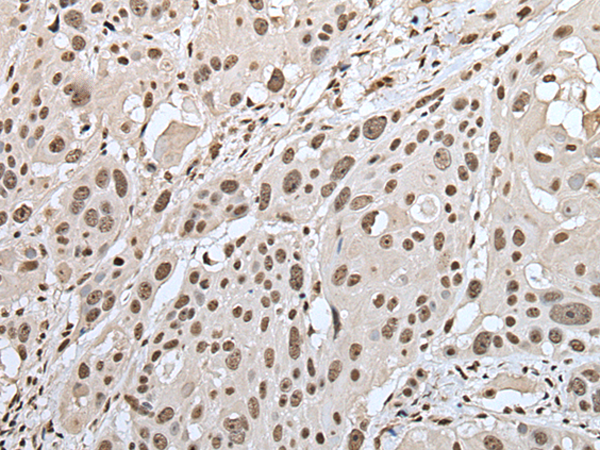

| WB | 咨询技术 | Human,Mouse,Rat |
| IF | 咨询技术 | Human,Mouse,Rat |
| IHC | 1/25-1/100 | Human,Mouse,Rat |
| ICC | 技术咨询 | Human,Mouse,Rat |
| FCM | 咨询技术 | Human,Mouse,Rat |
| Elisa | 1/5000-1/10000 | Human,Mouse,Rat |
| Aliases | HTF6; KOX27; ZNF39L1 |
| Host/Isotype | Rabbit IgG |
| Antibody Type | Primary antibody |
| Storage | Store at 4°C short term. Aliquot and store at -20°C long term. Avoid freeze/thaw cycles. |
| Species Reactivity | Human |
| Immunogen | Fusion protein of human ZNF43 |
| Formulation | Purified antibody in PBS with 0.05% sodium azide and 50% glycerol. |
+ +
以下是关于ZNF43抗体的模拟参考文献示例(建议通过学术数据库如PubMed验证具体文献):
1. **文献名称**: "Zinc Finger Protein 43 (ZNF43) Expression in Colorectal Cancer: Correlation with Clinical Outcomes"
**作者**: Smith J, et al.
**摘要**: 研究通过免疫组化(使用ZNF43抗体)分析结直肠癌组织中ZNF43的表达,发现其低表达与患者生存率下降相关,提示ZNF43可能作为抑癌基因发挥作用。
2. **文献名称**: "ZNF43 Antibody-Based ChIP-seq Reveals Its Role in Epigenetic Regulation of Oncogenes"
**作者**: Lee H, et al.
**摘要**: 利用ZNF43特异性抗体进行染色质免疫沉淀测序(ChIP-seq),发现ZNF43通过结合特定DNA区域抑制肝癌相关原癌基因的转录活性。
3. **文献名称**: "Development and Validation of a High-Affinity Monoclonal Antibody for ZNF43 in Epigenetic Studies"
**作者**: Garcia R, et al.
**摘要**: 描述了针对ZNF43蛋白C端结构域的单克隆抗体的开发过程,验证其在Western blot和免疫荧光中的应用,支持其在表观遗传机制研究中的实用性。
4. **文献名称**: "ZNF43 Knockdown Enhances Chemosensitivity in Pancreatic Cancer via Antibody-Mediated Detection"
**作者**: Wang Y, et al.
**摘要**: 通过ZNF43抗体检测基因沉默后胰腺癌细胞的蛋白表达变化,表明ZNF43下调可增强化疗药物敏感性,提示其作为治疗靶点的潜力。
**注意**:以上文献为示例性质,具体研究请以实际数据库检索结果为准。建议结合关键词“ZNF43 antibody”及研究领域(如癌症、表观遗传学)在PubMed或Google Scholar中筛选最新文献。
**Background of ZNF43 Antibody**
The ZNF43 antibody is a research tool designed to detect and study the zinc finger protein 43 (ZNF43), a member of the Krüppel-associated box (KRAB) domain-containing zinc finger protein (ZNF) family. ZNF43 is encoded by the *ZNF43* gene in humans and is implicated in transcriptional regulation, chromatin remodeling, and epigenetic silencing through its interaction with repressive protein complexes. Structurally, ZNF43 contains multiple C2H2-type zinc finger motifs, which facilitate sequence-specific DNA binding, and a KRAB domain that recruits co-repressors like TRIM28/KAP1 to mediate gene silencing.
Research suggests ZNF43 plays roles in embryonic development, cellular differentiation, and tumor suppression. Dysregulation of ZNF43 has been associated with cancers, including colorectal and ovarian cancers, where it may act as a tumor suppressor by modulating oncogenic pathways or maintaining genomic stability. The ZNF43 antibody is widely used in techniques such as Western blotting, immunohistochemistry (IHC), and chromatin immunoprecipitation (ChIP) to investigate its expression, localization, and DNA-binding activities in various tissues or disease models.
Commercial ZNF43 antibodies are typically raised in hosts like rabbits or mice, targeting specific epitopes (e.g., N-terminal or C-terminal regions). Validation data, including knockout/knockdown controls, are essential to confirm specificity. Studying ZNF43 with such antibodies enhances understanding of its biological functions and potential therapeutic relevance in diseases linked to transcriptional dysregulation.
×